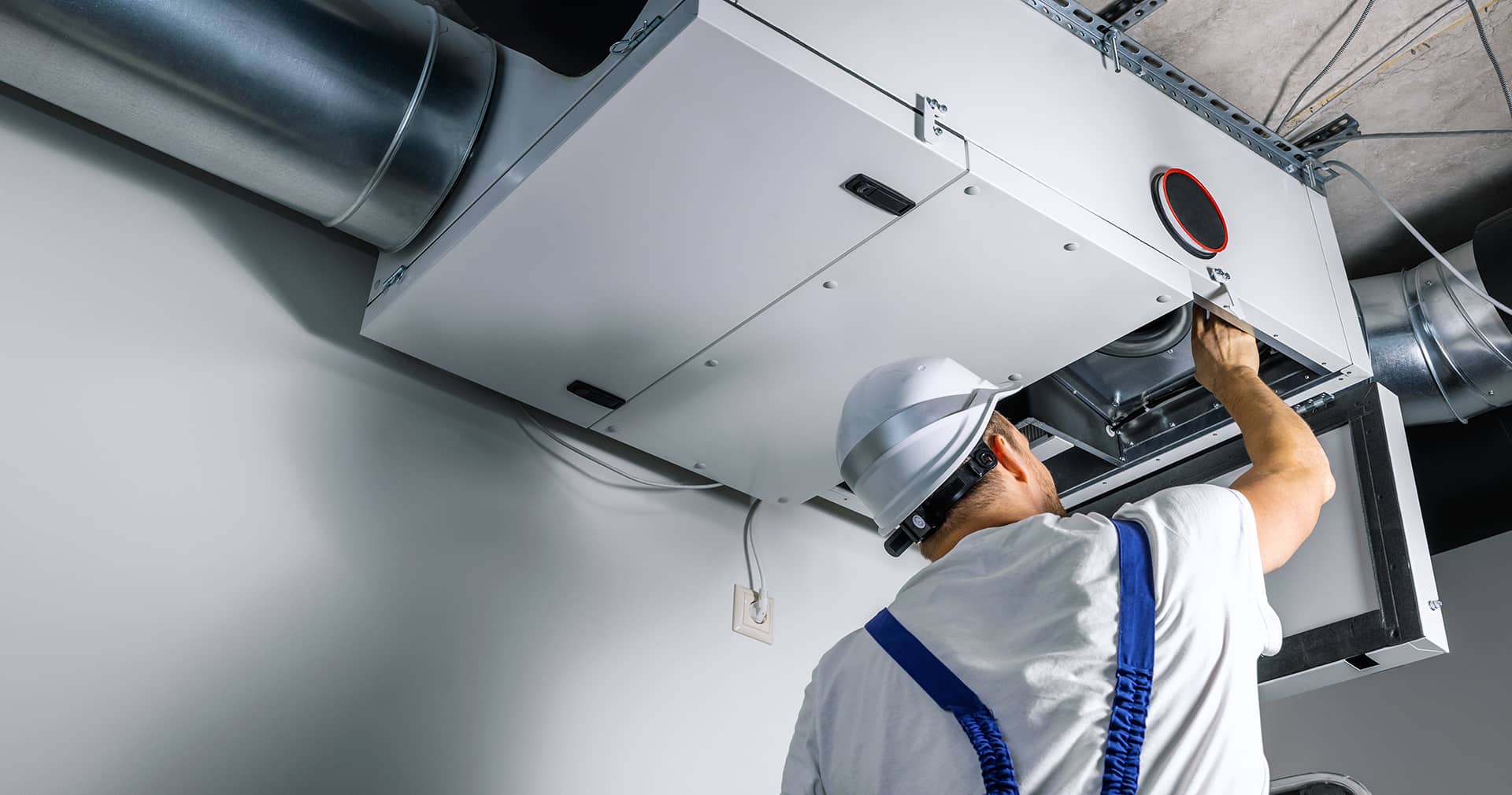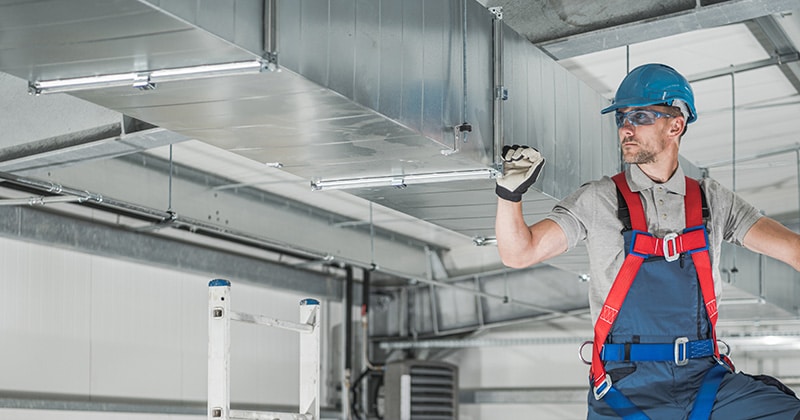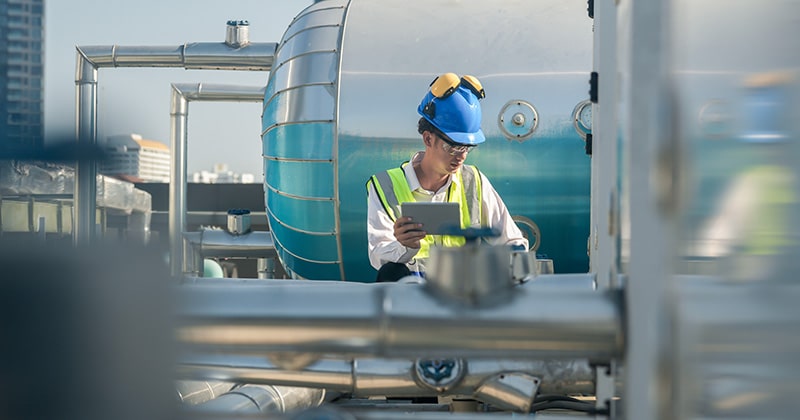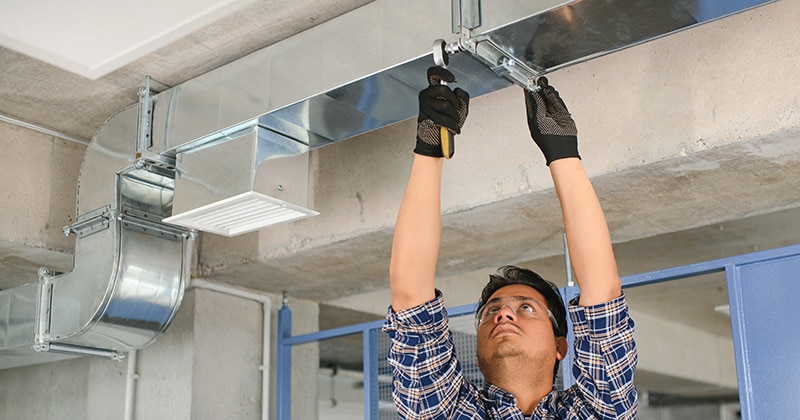
HVAC systems keep buildings and homes comfortable. But it’s not quite as simple as that.
There are different kinds of systems with different features. Some are more suited to commercial clients, while others are preferred by homeowners. Some are more costly but deliver extra benefits. And some are on the cheaper side.
As an HVAC professional, it’s your job to know the options inside and out. Why? Because the more you know, the more you can impress and delight your customers. You can deliver genuinely personalized services that keep clients happy and loyal.
If you’re keen to expand your knowledge and sharpen your expertise, you’ve come to the right place. This article is your go-to guide on all things VAV.
What is VAV in HVAC? We’ll explain it below. Then, we’ll look at how VAV systems differ from CAV systems.
We’ll also explore the benefits of VAV HVAC systems. You can use this information to inform your clients and encourage higher-value purchases.
We’ll discuss some of the top installation and maintenance concerns. Finally, we’ll conclude with a couple of big-picture basics—a too-long-didn’t-read (TL;DR) section.
Behind every successful business is a person who knows their stuff. Learn all about VAV in HVAC today and become an industry leader in your area. Let’s get started!
Understanding What VAV Is in HVAC Systems

What is VAV in HVAC?
Well, VAV stands for variable air volume. With a VAV HVAC system, you can control the airflow to different rooms, areas, or zones of a building.
For example, you might cool the floor of an occupied office building. You might leave an unoccupied floor with no cooling at all. That way, you don’t spend money or waste energy cooling down an area without people.
VAV systems are not like your traditional HVAC system. These deliver a constant amount of air. In contrast, a VAV adjusts the air volume up and down based on the needs of each area.
You get more control over heating and cooling. At the same time, the system is more efficient.
FROM ONE OF OUR PARTNERS
How to Start an HVAC Business: A Complete Guide
How Does a VAV System Work?
Let’s break it down.
In a VAV system, there is a central air handler. This device pushes conditioned air—heated or cooled—through the system’s ducts.
Now, each zone in the building has a VAV box. This controls how much air is let into the zone.
It takes the zone’s existing temperature and considers the set temperature. Then, it automatically adjusts how much air to let flow through.
For example, let’s say the temperature in a room is a few degrees over the set temperature. The VAV box will allow more air from the central air handler into the room. It will continue doing this until the temperature reaches the setting.
We can’t forget the thermostat, either. Each area, room, or zone has one, which connects to and communicates with the VAV box.
When the temperature hits the desired set point, the box reduces the airflow. It might even shut off completely.
VAV vs. CAV HVAC Systems
We touched on it briefly above, but let’s look at the differences between VAV and CAV—constant air volume—in a little more detail.
A CAV system delivers a constant amount of air to an area. It does this no matter what the temperature is compared to the setting.
To heat or cool a space, the system changes the temperature of the air. It doesn’t change the volume of air.
This is different from a VAV system, where the amount of air supplied matches the demand.
The table below explores some of the fundamental differences between the two.
| Feature | VAV Systems | CAV Systems |
| Airflow Control | Adjusts the volume of air based on zone needs | Delivers constant airflow volume regardless of what’s needed |
| Energy Efficiency | More efficient | Less efficient |
| Comfort | Offers better comfort by adjusting airflow to match temperature | Less precise control over comfort levels |
| System Complexity | More complex and requires zone-specific control and components | Simpler system with fewer moving parts |
| Cost | Higher upfront cost but saves on energy bills long-term | Lower initial cost but less energy savings |
| Use Case | Ideal for buildings with varying temperature needs in different zones | Suited for spaces with uniform heating or cooling needs |
To sum up, here are the key differences:
- VAV adjusts airflow, while CAV maintains a constant airflow.
- VAV systems provide better energy savings. They control airflow based on the zone’s needs.
- VAV allows for more precise comfort in individual areas. These systems are ideal for multi-zone buildings.
RELATED ARTICLE
What Is CFM in HVAC? Understanding Airflow in HVAC Systems
Benefits of VAV HVAC Systems

You want to give your clients a solution that meets their needs. Even more than that, you want your work to deliver long-term value. Installing a VAV system can help you achieve both of these goals.
Although more advanced and potentially costlier, they have a whole list of advantages. Here are just four of these benefits and what they mean for your customer and business:
Improved Energy Efficiency
Many consumers are aware of the environmental impact of their buying decisions. It’s why almost half see energy efficiency as a must-have when purchasing appliances.
At the same time, many businesses are grappling with rising energy costs. They are looking for ways to save. This makes more efficient HVAC solutions more attractive.
VAV systems adjust the volume of air delivered based on real-time needs. This means they use the least amount of energy required.
In contrast, CAV systems push out the same level of air at all times. Businesses pay for heating or cooling power when they don’t need it.
Your clients benefit from:
- Lower energy bills
- Savings on utility costs
- More money to invest in their growth
Your business benefits from:
- Using energy efficiency as a selling point
- Showing you can meet your clients’ specific needs and pain points
- More trust with clients and increased repeat business
Greater Comfort
Some like it hot. And some like it cold. A VAV system has a knack for keeping everyone happy—no matter their preferences.
How? Each zone has independent control over temperature. So, if one part of the building needs more cooling, the VAV box will increase airflow. And other zones? They won’t be affected at all.
Your clients benefit from:
- Tailored temperature control that keeps everyone happy
- In office buildings, happier, more comfortable employees might be more productive
Your business benefits from:
- Greater client satisfaction
- Fewer callbacks, which means more time to dedicate to other jobs
- More five-star reviews and word-of-mouth referrals
Less Wear and Tear on Equipment
HVAC systems don’t last forever. But by opting for a VAV system, you can increase their lifespan.
Think about it like this. Over a year, a VAV system will deliver less air than a CAV system. It doesn’t work as hard, so the HVAC equipment is less strained.
Components like compressors and blowers last longer, contributing to cost savings.
Your clients benefit from:
- Lower maintenance expenses
- Fewer repairs, which means less downtime
- Longer-lasting HVAC system, which adds to their cost savings
Your business benefits from:
- Fewer emergency callouts, so you can better manage your resources
- More time to focus on services with higher profit margins, like new installations
Flexibility for Future Expansions
VAV systems are flexible. Adding new VAV boxes or adjusting airflow patterns is more straightforward than other system types.
If your client needs new zones added, that’s no hassle at all. You can expand the system to accommodate these changes. The same goes for those who want to pare back their HVAC system.
Your clients benefit from:
- A scalable system that continues to meet their needs
- A future-proof investment that’ll last them years—regardless of their growth
- Quick and easy HVAC updates that don’t cost a fortune or result in lengthy downtime
Your business benefits from:
- Longer-lasting relationships with your clients
- Recurring revenue opportunities, as clients are likely to turn to you for future upgrades
- A more diverse range of services
RELATED ARTICLE
HVAC Business Management 101: 9 Key Concepts
Installation and Maintenance Concerns with VAV HVAC Systems

VAV HVAC systems are excellent—there’s no doubt about their benefits. But like most great things in life, there are considerations to keep in mind.
To really squeeze the most value out of a VAV system, you need a proper setup. You also need to offer ongoing care.
Below are seven key areas to focus on. Achieve these, and you help your clients steer clear of common heating and cooling issues.
Make Sure the System Is the Right Size
You must size the VAV system with razor-sharp accuracy. The size will depend on the physical space and specific demands of the building and its occupants.
A system that’s too big will cycle on and off too frequently. Expect increased wear and higher energy costs.
Conversely, a system that is too small will not be able to achieve the desired temperatures.
The solution? Always perform detailed load calculations for each zone.
Carefully Design the Zoning and Ductwork
Start by collaborating with your client to define each zone. Then, design ductwork to distribute the right amount of air to each zone.
If your ductwork is uneven, the airflow will be interrupted. This can cause temperatures to become unpredictable.
The solution? Balance airflow and pressure in each zone’s ducts. Balancing dampers are used to fine-tune the air distribution.
Choose the Best Thermostat Placement
Each VAV box is controlled by a thermostat. The placement of these thermostats is crucial.
For example, say you install it in a location that gets direct sunlight. The thermostat will think it’s much warmer in the zone than it actually is.
Watch out for equipment heat and drafts, too.
The solution? Find a central, well-ventilated area within the zone. This will give true-to-life readings for reliable temperature control.
Calibrate the VAV Box
You’ll need to calibrate the VAV box.
This step makes sure that the system lets the right amount of air through. If the calibration isn’t quite right, your client could end up wasting energy on unneeded airflow.
The solution? Calibrate each VAV box separately. Use the zone’s temperature and airflow needs as guides.
Integrate the System with Building Controls
If you’re installing the VAV system in a modern building, consider integration.
Many commercial premises use advanced building management systems (BMS). These monitor and manage the HVAC system from a central place.
A new VAV system needs to be connected to the BMS. Proper integration allows the various heating and cooling components to communicate.
The solution? Make sure the VAV system is compatible with the building’s existing BMS.
Balance the Airflow
This is one of the most important steps following a VAV system installation. Without it, some zones will get too much air. Others will be lacking.
In other words, poor balancing can compromise the system’s effectiveness. Your clients won’t be comfortable, which is a bad look for your business.
The solution? Always perform airflow testing and balancing. Do this in every zone. Make tweaks to the dampers and diffusers as needed.
Maintain the Filter and Other Components
VAV systems last longer and require less maintenance. But a quick check-in now and again is critical to smooth operations.
Change the filters when they become dirty. This ensures air can flow effortlessly through the system without getting caught.
Inspect actuators, control boards, and other components. Make sure they are functioning as intended.
The solution? Set up a regular maintenance schedule. Include filter changes, thermostat checks, and VAV box inspections.
FROM ONE OF OUR PARTNERS
The Best HVAC Technician Training Programs in the U.S.
What Is VAV in HVAC: The Basics
What are the key takeaways? Here’s our version of a TL;DR:
- VAV systems control the volume of air delivered to each zone based on temperature needs. It’s variable. This is unlike CAV systems, which deliver a constant amount of air.
- Each zone in a building has a VAV box. This adjusts the amount of air entering that space.
- VAV systems save energy by reducing airflow when demand is low. This leads to lower energy bills and less wear and tear.
- Each zone has its own thermostat. The temperature can be controlled precisely.
Related Posts
Power Up Home Heating Design with Amply Energy’s HVAC Business Software
Continue ReadingHow to Get Painting Jobs: Effective Strategies for Growth
Continue ReadingStay Informed
Get the latest news and insights plus, Service Fusion offers and updates.Thank you for your submission.

SHARE